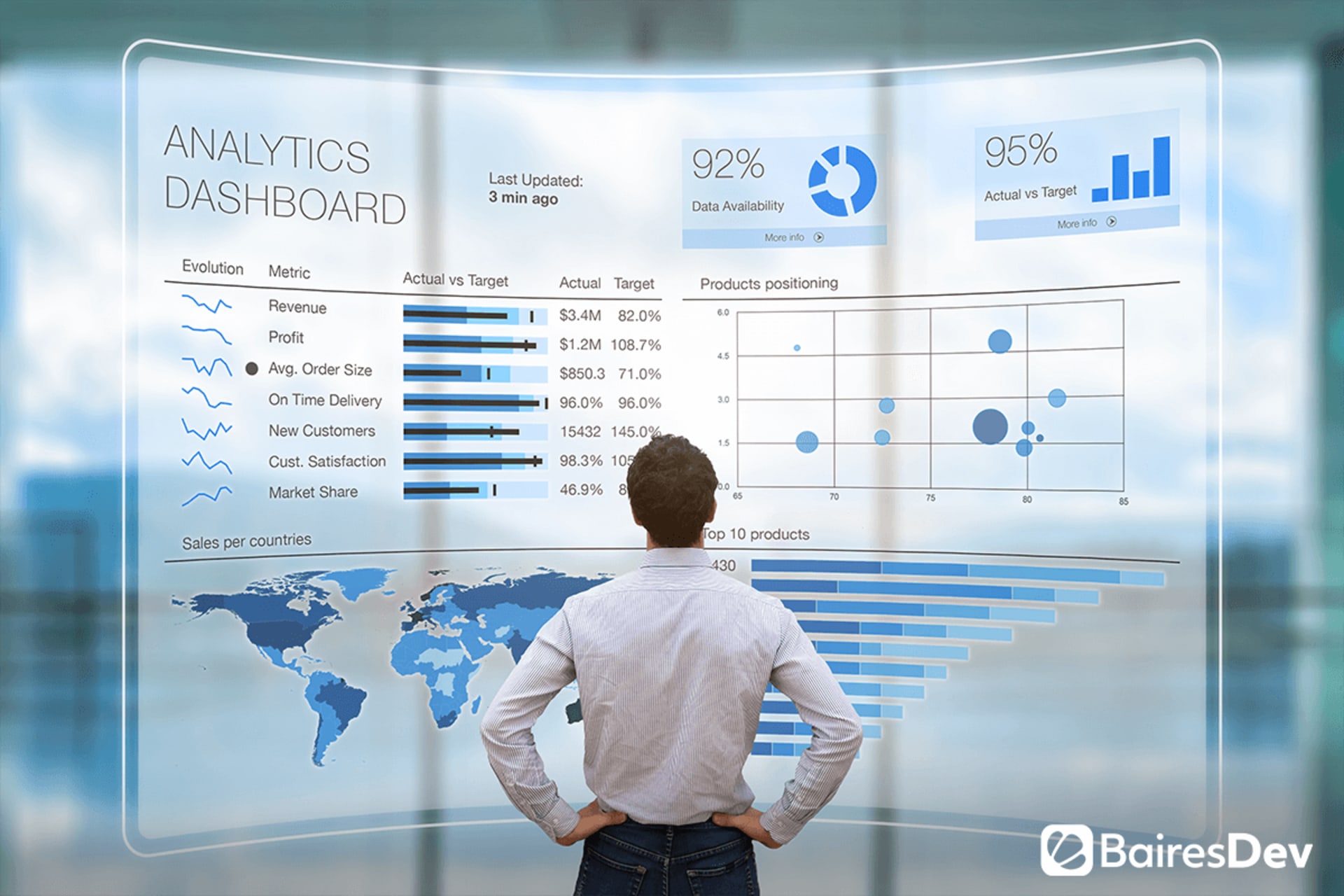Data Analytics Company
Our Data Analytics development services already power dozens of active engagements. We typically land our teams within 2 weeks, so you can start shipping top quality software, fast.
500+ companies rely on our top 1% tech talent.
Data Analytics Services We Provide
Data Collection & Integration
Efficiently gather and integrate diverse data sources. Using technologies like Apache Kafka and Microsoft Azure Data Factory, we ensure a cohesive flow of data and optimize your data ecosystem for accuracy and accessibility.
Data Warehousing & Management Solutions
Optimize data storage and management with our data warehousing solutions. Leveraging technologies like Amazon Redshift and Snowflake, we design and implement scalable and high-performance data warehouse solutions tailored to your business needs. The result is quick and reliable access to critical information.
Business Intelligence & Reporting
Transform raw data into actionable insights. Using tools like Tableau and Power BI, we develop intuitive dashboards and reports for your team, so you can make more informed decisions and enhance overall business performance.
Predictive Analytics & Modeling
Predictive analytics and modeling services help you harness the power of data to gain a competitive edge in your industry. Employing machine learning algorithms and tools like Python's scikit-learn, we build predictive models that empower your business with foresight, facilitating strategic planning and risk management.
Big Data Analytics
Utilizing technologies like Apache Spark and Hadoop, we build systems for your team to process and analyze massive datasets. From there, you can extract valuable insights that drive innovation and efficiency and can give your business a competitive advantage.
ML & Artificial Intelligence Development
Integrate machine learning and artificial intelligence into your applications to boost data compilation capabilities and automate analytics. Leveraging deep-learning frameworks like TensorFlow and PyTorch, we design intelligent systems that continuously learn and adapt.
Data Visualization & Dashboard Creation
Translate complex data into visually compelling insights with our data visualization and dashboard creation services. Using tools like D3.js and Tableau, we create interactive visualizations that facilitate intuitive data exploration and an easy-to-navigate and accessible dashboard.
Data Security & Privacy Solutions
Safeguard sensitive information and valuable data assets. Employing encryption, access controls, and compliance frameworks like GDPR and HIPAA, we ensure the confidentiality and integrity of your data, fostering trust and compliance with regulatory standards.
Data Governance & Compliance Solutions
Establish data governance frameworks and ensure compliance with our data governance and compliance solutions. Using tools like Collibra and IBM InfoSphere, we implement policies and procedures that govern data usage, quality, and lifecycle, fostering a secure and compliant data environment.
Real-time Analytics & Monitoring
Gain instant insights into your data with our real-time analytics and monitoring services. Leveraging technologies like Apache Flink and Elasticsearch, we implement real-time analytics solutions that empower your team to make timely decisions based on the most current information available.
Key Things to Know About Data Analytics
Best Practices for Data Analytics
Enforce comprehensive data governance policies, defining rules and standards for data management and usage throughout the organization.
Institute robust data quality measures, including validation checks and cleansing processes, to ensure the accuracy and reliability of your data.
Prioritize data privacy and compliance by implementing secure data handling practices, encrypting sensitive information, and adhering to relevant requirements and regulations.
Design and implement a scalable data architecture that accommodates growing data volumes, allowing for the efficient storage, retrieval, and processing of information.
Harness advanced analytics and machine-learning techniques to extract valuable insights, identify patterns, and improve predictive modeling capabilities.
Gain actionable insights by aligning data analytics efforts with strategic business goals. This ensures that the insights you derive have the potential to lead to tangible improvements.
Employ effective data visualization techniques and tools to communicate complex findings in a clear and accessible way, facilitating stronger collaboration and sounder decision-making.
Regularly validate and refine analytical models to ensure they remain accurate and relevant in the evolving business landscape.
Choose appropriate tools for data storage, processing, and analysis based on the specific requirements of the analytics project, considering factors like scalability and compatibility.
Implement automated data pipelines to streamline the collection, processing, and analysis of data, enhancing efficiency, reducing manual intervention, and minimizing human error.
Stay abreast of emerging technologies in the data analytics space, adopting new tools and methodologies that can enhance the effectiveness of analytics initiatives.
Utilize cloud services to achieve scalability, flexibility, and cost-effectiveness in data analytics operations, allowing for dynamic resource allocation based on demand.
Cultivate a data-driven culture within the organization, emphasizing the importance of data-driven decision-making and encouraging employees to use data in their daily activities.
Promote collaboration between different departments and teams, fostering a cross-functional approach to data analytics that integrates diverse perspectives and expertise.
Effectively communicate insights to stakeholders by translating complex analytics findings into actionable and understandable information.
Integrate data analytics into the strategic decision-making process, ensuring that insights derived from data are actively used to inform and shape the organization's overarching strategy.
Why Choose BairesDev for Data Analytics Development

Custom Solutions
We specialize in developing custom solutions for data analytics, tailoring our expertise to address your diverse data challenges. We focus on understanding your specific business requirements to ensure the timely delivery of innovative data analytics solutions.
Diverse Range of Talent
Our data analytics professionals have diverse talents, bringing varied skills and perspectives to the table—from developers to designers with expertise in many different industries. This diversity of talent fosters creativity and enables us to approach data challenges with a comprehensive set of skills, ensuring successful analytics implementations.
Diverse Range of Solutions
Explore a broad range of solutions tailored to your business' distinct data needs. Our data analytics services encompass a wide range of solutions, such as descriptive analytics tools and big data analytics platforms. This affords you the flexibility and scalability to address various aspects of your data analytics needs.
Our process. Simple, seamless, streamlined.
During our first discussion, we'll delve into your business goals, budget, and timeline. This stage helps us gauge whether you’ll need a dedicated software development team or one of our other engagement models (staff augmentation or end-to-end software outsourcing).
We’ll formulate a detailed strategy that outlines our approach to backend development, aligned with your specific needs and chosen engagement model. Get a team of top 1% specialists working for you.
With the strategy in place and the team assembled, we'll commence work. As we navigate through the development phase, we commit to regularly updating you on the progress, keeping a close eye on vital metrics to ensure transparency and alignment with your goals.
Frequently Asked Questions (FAQ)
What is data analytics development outsourcing?
Data analytics development outsourcing involves working with an outside data analytics company to perform tasks such as data collection, cleaning, analysis, modeling, and interpretation. The goal is to leverage data more effectively to improve business decisions.
Why do companies outsource data analytics?
Companies may outsource data analytics to access specialized skills, achieve greater scalability, or reduce costs, among other reasons. An outsourcing partner can help them improve data management and data integration.
What should I consider when choosing an outsourcing partner for data analytics?
When choosing a data and analytics services provider, consider factors like data security and privacy measures, communication and collaboration, and a proven track record. You can evaluate the provider's experience by looking at their portfolio and asking for referrals and references.
How can I ensure data security when outsourcing data analytics?
When you outsource data analytics to us, we ensure data security through measures like strong data security protocols, data anonymization, regular security audits, and strict NDAs.
How are data science and data analytics related?
Data analytics is a subfield of data science. Data science involves creating algorithms, predictive models, and data processing techniques to extract valuable information and insights. Data analytics specifically focuses on processing and performing statistical analysis on existing datasets.
How Businesses Can Overcome the Software Development Shortage
BairesDev Ranked as one of the Fastest-Growing Companies in the US by Inc. 5000

See how we can help.Schedule a Call










